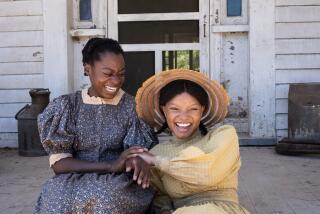Dramatic Stroke on an ImaginaryVermeer
- Share via
Fortunately for actress Glenn Close, but to the surprise of those who read Susan Vreeland’s 1998 novel, “Girl in Hyacinth Blue,” one of the lead characters in the Hallmark Hall of Fame adaptation “Brush With Fate,” which premieres Sunday on CBS, has been transformed from a male to a female. Given the film’s painterly subject matter, you could call it artistic license.
The drama tracks a “lost” canvas by Dutch artist Jan Vermeer since it was painted in the 17th century. (The painting is an imagined work by Vreeland.) Close plays the character who was a male in the novel: an eccentric teacher at a high school who is secretly in possession of the painting and has devoted her life to researching its colorful but often painful history. When a new art teacher (Thomas Gibson) arrives at the private school, she decides to share her passion and devotion to the painting as well as its amazing history with the young man. She also introduces him to her father, wheelchair-bound and speechless after several strokes, who obtained the painting under horrific circumstances in World War II. Ellen Burstyn also stars as one of the previous owners of the painting.
Vreeland thought that making the character a female worked beautifully for the movie. She was under the impression the teacher was changed by director Brent Shields and adapter Richard Russo because “a couple of male actors they were thinking of offering the role to weren’t available at the time. It wasn’t a gender specific role.”
Shields, who also produced the drama, one of the most ambitious Hallmark productions ever, says that wasn’t the case. He always wanted to change the role to a woman. “I wanted to capitalize on the father-daughter relationship,” says Shields, who has a daughter. “I thought it paralleled a lot of our stories and it is something I can personally relate to. I thought we could get more dramatic power. There is that loyalty, that power, those specific relationships that fathers and daughters have.”
Close is almost unrecognizable in the film with her nondescript hair, dowdy clothes and glasses that are Coke-bottle thick. The spectacles, says Shields, are something “she really worked with.” She even contacted an ophthalmologist about eye conditions that would lead to someone having to wear those type of glasses.
“I thought how wonderful that she has this kind of love for this painting which she has a great difficulty in actually seeing,” says Close. “And through her obsession with research, she has acerbated her eyesight, and it also made her more isolated I think.”
Close also created a back-story on the relationship of the woman and her father. “She didn’t have a happy life. And what you see is the result of her entire life knowing the story [of how her father got the painting]. And if it was fake, how even more horrible I think it was for her. I think for me, what compelled her to do all the research was to validate the picture and validate her life.”
Shields sees the piece, which was shot in the Netherlands in 36 days, as an examination of the ability of art to endure and influence lives. “So much today competes with our daily life, but at one time a painting like this would have an influence on a farmer. Artwork could have a profound effect: a ray of sunshine and hope and the whole thing about art not being disposable.”
“This issue I wanted to raise,” adds Vreeland, “is do we value a piece of art because there is a famous name attached to it, or do we seek other qualities in it that speak to us.”
“Hallmark Hall of Fame: Brush With Fate” can be seen Sunday at 9 p.m. on CBS. The network has rated it TV-PG (may be unsuitable for young children).
Cover photograph by Erik Heinila.
More to Read
Only good movies
Get the Indie Focus newsletter, Mark Olsen's weekly guide to the world of cinema.
You may occasionally receive promotional content from the Los Angeles Times.










